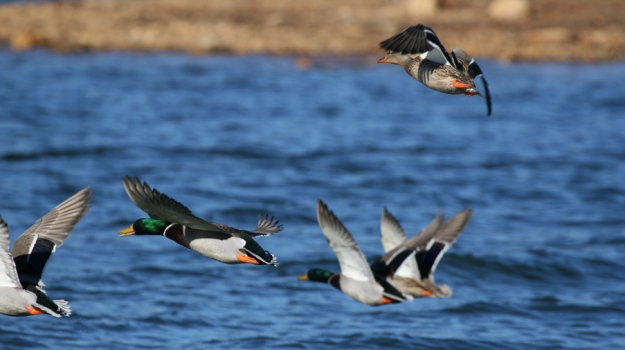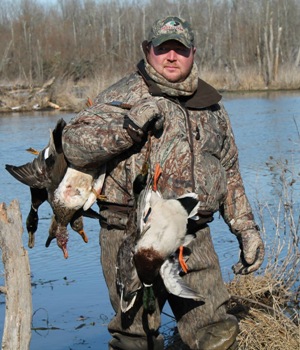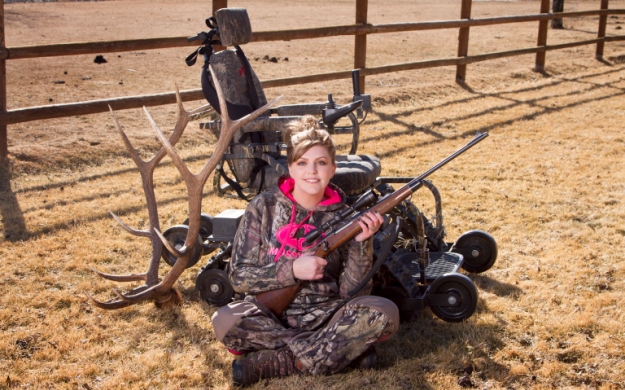
On public lands, we don’t get out on the water to hunt until about 9 or 10 a.m. Like most public land hunters, we scout the waterways in our boats to see where the ducks are holding. However, more than likely all the other serious duck hunters have scouted the same waterways and found the same ducks that we’ve located. Most typical duck hunters will get out and set up before daylight and either have taken their limits or run out of shells by 7 - 8 a.m. Then those early-morning ducks will have had a chance to regroup and return to the places they’ve wanted to be at early light. When we come in to hunt at 9 a.m., those ducks know that a boat that’s moving generally doesn’t have any shooters in it. So, the areas we flush ducks out of in our boat as we’re going to hunt are the places where we’ll set up our boat blind and prepare to hunt. When ducks are sitting on the water at 9 or 10 a.m., they’re telling us where they want to be. Then after setting up our blind, all we have to do is wait for the ducks to return. Most of the public places we hunt require hunters to leave and be out of the water by 1 or 2 p.m. We’ve learned we get our best shooting and take the most ducks from 10 a.m. until 1 p.m. Most of the other hunters already have put their boats on trailers and gone home, so there’s less hunting pressure, and most of the public waterfowl areas will have places for ducks to feed and rest. Once the hunting pressure shrinks or is almost non-existent from 10 a.m. - 1 p.m., the ducks usually don’t hesitate to return to the spots where we’ve flushed them as we’ve gone to our hunting site. Our duck hunting on public lands is much like deer hunting on public lands. We hunt where other hunters aren’t at a time of day when other hunters aren’t and frequent a place where few, if any other hunters and the ducks least expect us to be.
 Another secret for taking waterfowl on public lands is not to hunt on the weekends. Most waterfowl hunters have to work all the weekdays and hunt on the weekends. Many times when we go to public waterfowl areas in the middle of the week, we’ll be the only waterfowl hunters on all of that public land. Also, most public land hunters who can and do hunt in the middle of the week are gone by 9 or 10 a.m. when we arrive to hunt. Another secret to successful public land hunting is we identify a place where the ducks are coming in heavy. Then we may shoot that same place for 2 or 3 days. However, the tactic we must use is what I call, picking ducks. We’ll shoot one location, the next day we’ll shoot another spot and the next day even another place. None of the locations we choose to set-up on generally are more than 100 yards away from the day before.
Another secret for taking waterfowl on public lands is not to hunt on the weekends. Most waterfowl hunters have to work all the weekdays and hunt on the weekends. Many times when we go to public waterfowl areas in the middle of the week, we’ll be the only waterfowl hunters on all of that public land. Also, most public land hunters who can and do hunt in the middle of the week are gone by 9 or 10 a.m. when we arrive to hunt. Another secret to successful public land hunting is we identify a place where the ducks are coming in heavy. Then we may shoot that same place for 2 or 3 days. However, the tactic we must use is what I call, picking ducks. We’ll shoot one location, the next day we’ll shoot another spot and the next day even another place. None of the locations we choose to set-up on generally are more than 100 yards away from the day before.
Yet another secret that helps us take limits of ducks on public land is we make our decoy set look as real as possible. We use the Avery Pro-Grade Floater floating decoys with the flocked heads on the mallards. But I’m also mixing black duck decoys in my decoy spread. Oftentimes the floating duck decoys blend in with the woods where we have them set up; and that’s what real ducks want to do is blend in with the background so that hawks, owls and other critters can’t see them. But we’ve learned by putting black duck decoys in with our mallard decoys that ducks in the air may see those black decoys better than they can see those natural-looking mallard decoys. We also vary the number of decoys in our spread. Some days we may put out 8–10 dozen, on other days, we may put out only 3 dozen decoys. If we have a large number of ducks in the area where we’re hunting, and those ducks are staying in our area, then I only may put out 2 or 3 dozen decoys. However, if we have “trading ducks” - ducks flying from one spot to another spot but not on a major traveling route from a refuge to big water or from refuge to refuge - I’ll put out a bigger spread of from 8-10 dozen decoys. Then the ducks can see them better, and that many decoys can pull the ducks to my blind better too.
Day 2: Cutting Brush Before Waterfowl Season
Tomorrow: Learning the Primary Ducks in an Area and Hunting Private Lands






























